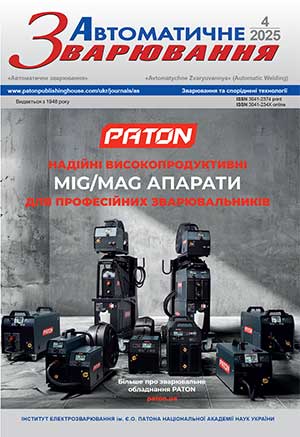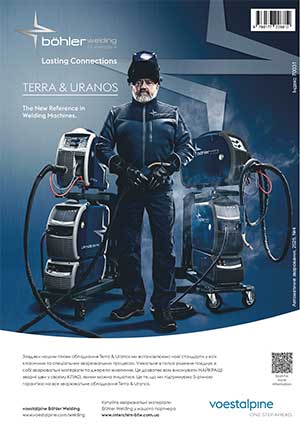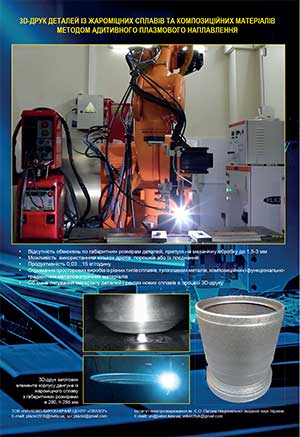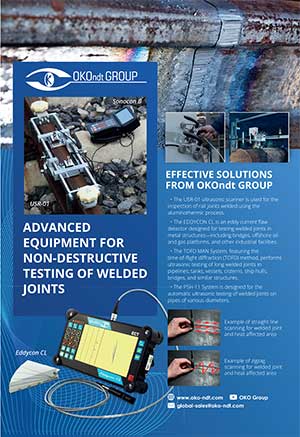| 2025 №04 (06) |
DOI of Article 10.37434/as2025.04.07 |
2025 №04 (08) |
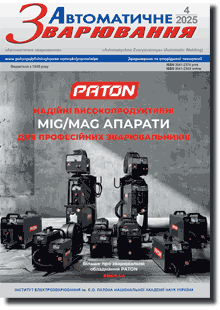
"Avtomatychne Zvaryuvannya" (Automatic Welding), #4, 2024, pp. 47-53
Electroslag welding of 09G2S steel of small thickness
P.I. Onyshchenko, S.M. Kozulin
E.O. Paton Electric Welding Institute of the NAS of Ukraine 11 Kazymyr Malevych Str., 03150, Kyiv, Ukraine. E-mail: pwi_37@ukr.netУThe paper presents the results of studies of the possibility of obtaining a high-quality welded joint in ESW of 09G2S steel with a thickness of 20 mm using wires 1.6, 2.0 and 3.0 mm in diameter. The aim of the work is to develop a technology and technique for ESW of 20 mm thick metal that ensures process stability, high-quality weld formation and the required mechanical properties of welded joints. The main tasks of the work are: laboratory experimental studies to establish the modes and techniques of ESW in the conditions of a small cross-section of the joint; comparative assessment of the depth of base metal penetration and the cross-sectional areas of welds made by ESW with electrode wires of different diameters; study of macro- and microstructure of welded joints; measurement of hardness of the base metal and the weld and HAZ metal; determination of grain size in the characteristic areas of welded joints; testing of the weld and HAZ metal and base metal for impact bending. Modern welding equipment with an inverter power source and high-speed wire feed mechanisms allowed using a wire with a diameter of 1.6 mm, which enabled reducing the gap between the edges by 30% and increasing the welding speed by 1.5 times, lowering the specific linear energy from 162 kJ/cm2 to 109 kJ/cm2 and reducing the dimensions of the joint: of the weld area by 40%, and of the HAZ by 20%, compared to welding with a 3.0 mm wire. No defects were found as a result of metallographic studies of the joints. Analysis of the metal microstructure in the main areas of the joint showed that a homogeneous structure of acicular ferrite with polygonal ferrite areas and a hardness of 54...57 HRA is formed in the weld metal, and a bainitic structure with polygonal ferrite areas and a hardness of 54 to 57 HRA is formed in the HAZ metal. The use of higher alloyed wire grades increased the impact toughness of the weld metal by 55% (up to 120 J/cm²) (at +200 C°). 17 Ref., 4 Tabl., 10 Fig.
Keywords: low-alloy steel, electroslag welding, electrode wires, hardness, macrostructure, microstructure, grain size, impact toughness
Received: 14.05.2025
Received in revised form: 17.06.2025
Accepted: 25.07.2025
References
1. Lashchenko, G.I. (2019) Welding production in the economy of Ukraine. The Paton Welding J., 11, 2-7. https://doi.org/10.15407/tpwj2019.11.012. Yushchenko, K.A., Lychko, I.I., Kozulin, S.M., Fomakin, A.A., Nesena, I.S. (2018) Application of electroslag welding in construction. The Paton Welding J., 9, 23-27. https://doi.org/10.15407/as2018.09.05
3. Sushchuk-Slyusarenko, I.I., Lychko, I.I., Kozulin, M.G., Semenov, V.M. (1989) Electroslag welding and surfacing in repair work. Kyiv, Naukova Dumka [in Russian].
4. Turpin, B., Danks, D. (2002) Electroslag field welding of railroad rail. IDEA program final report for the period September 2002 to November 2003. Contract number HSR-37.
5. (1974) Technology of electric welding of metals and alloys by fusion. Ed. by B.E. Paton. Moscow, Mashinostroenie [in Russian].
6. Avramenko, V.I., Bogdanovsky, V.A. (1976) Technology of electric arc and electroslag welding of carbon and low-alloy steels. Kyiv, Naukova Dumka [in Russian].
7. Reznik, S.A., Kozulin, S.M., Suprun, S.O. (2024) Improvement of technology and equipment for welding vertical joints with forced seam formation. Avtomatychne Zvaryuvanniya, 5, 48-54. https://doi.org/10.37434/as2024.05.06
8. Sasaki, S., Suda, K., Motomatsu, R., Hashiba, Y., Ohkita, S., Imai, S. (2004) Development of two-electrode electrogas arc welding process. Nippon Steel Technical Report № 90, July 2004. https://www.nipponsteel.com/en/tech/report/nsc/pdf/n9013.pdf
9. Tereshchenko, V.I., Libanov, A.V. (1987) Selection and application of welding methods in the manufacture of structures. Kyiv, Naukova Dumka [in Russian].
10. (1980) Electroslag welding and surfacing. Ed. by B.E. Paton. Moscow, Mashinostroenie [in Russian].
11. Paton, B.E., Yushchenko, K.A., Kozulin, S.M., Lychko, I.I. (2019) Electroslag welding process. Analysis of the state and development trends (Overview). The Paton Welding J., 10, 33-40. https://doi.org/10.15407/tpwj2019.10.05
12. Turpin, B., Danks, D., Callaghan, I., Wood, W. (2012) Narrow gap electroslag is process of choice for welding San Francisco-Oakland Bay Bridge. Welding J., 91(5), 24-31.
13. Chambers, J.J., Manning, B.R. (2016) Electroslag welding: From shop to field. Structure magazine, February 2016, 20-23.
14. DSTU 3490-96. Electroslag welding of steels. Requirements for the technological process [in Ukrainian].
15. DSTU 8975:2019. Steel. Methods of testing and evaluation of macrostructure [in Ukrainian].
16. DSTU ISO 6508-1:2013. Metallic materials. Determination of Rockwell hardness. Pt 1. Test method (scales A, B, C, D, E, F, G, H, K, N, T) (ISO 6508-1:2005, IDT) [in Ukrainian].
17. 17.DSTU 8972:2019. Steels and alloys. Methods for detecting and determining grain size [in Ukrainian].

